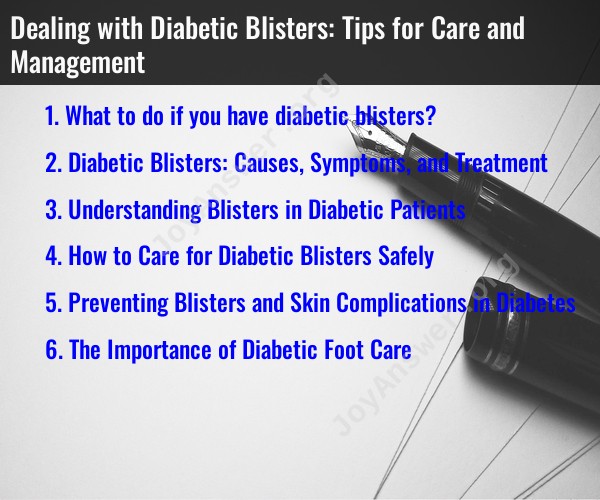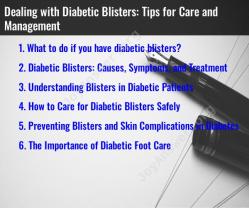What to do if you have diabetic blisters?
If you have diabetic blisters, it's important to take care of them properly to prevent infection and promote healing. Diabetic blisters, also known as bullosis diabeticorum, are a rare condition that can occur in people with diabetes. They are fluid-filled sacs that appear without any obvious cause, often on the legs and feet. Here are some tips for care and management:
Don't Pop the Blisters:
- Resist the urge to pop the blisters. Popping them can introduce bacteria and increase the risk of infection. Diabetic skin is more prone to infections, so it's crucial to keep the skin intact.
Cleanse Gently:
- Wash the area around the blisters with mild soap and warm water. Avoid scrubbing or using hot water, as it can be harsh on the skin. Pat the area dry with a clean, soft towel.
Apply Antibiotic Ointment:
- If your healthcare provider recommends it, apply a thin layer of antibiotic ointment to the blisters. This can help prevent infection.
Protect the Blisters:
- Cover the blisters with a sterile, non-stick bandage or dressing. This will help protect them from friction and reduce the risk of infection.
Change Dressings Regularly:
- Change the bandage or dressing daily or as directed by your healthcare provider. This will keep the blisters clean and allow for proper healing.
Wear Loose, Comfortable Footwear:
- Choose footwear that doesn't rub against the blisters. Loose-fitting shoes and socks can help prevent further irritation.
Monitor for Signs of Infection:
- Keep a close eye on the blisters for any signs of infection, such as redness, increased pain, swelling, or discharge. If you suspect an infection, contact your healthcare provider promptly.
Control Blood Sugar Levels:
- Good blood sugar control is essential for preventing diabetic complications. Follow your diabetes management plan to keep your blood sugar within a healthy range.
Consult a Healthcare Provider:
- If you develop diabetic blisters, it's advisable to consult your healthcare provider or a wound care specialist. They can assess the condition, provide proper care instructions, and monitor the healing progress.
Avoid Home Remedies:
- Steer clear of home remedies like puncturing or draining the blisters, using harsh chemicals, or using adhesive bandages. These can cause more harm than good.
Elevate Your Feet:
- If the blisters are on your legs or feet, try elevating your legs when sitting to reduce swelling and promote circulation.
Prevent Recurrence:
- Work with your healthcare team to identify the underlying cause of the blisters, which may be related to poor circulation, neuropathy, or other diabetic complications. Addressing these underlying issues can help prevent future occurrences.
Remember, it's essential to take diabetic blisters seriously, as they can lead to complications if not managed properly. Always seek guidance from a healthcare professional for specific advice tailored to your situation, as the management of diabetic blisters can vary from person to person.
Diabetic Blisters: Causes, Symptoms, and Treatment
Diabetic blisters, also known as bullosis diabeticorum, are rare skin complications that can occur in people with diabetes. They are typically painless and appear on the hands, feet, and forearms. The blisters are caused by a combination of factors, including poor circulation, nerve damage, and high blood sugar levels.
Symptoms
Diabetic blisters can range in size from small to large. They are typically filled with a clear fluid, but they can also become bloody or infected. Other symptoms of diabetic blisters include:
- Redness and swelling around the blister
- Warmth around the blister
- Pain or tenderness (although this is less common)
Treatment
The most important treatment for diabetic blisters is to keep them clean and protected. This will help to prevent infection. You can do this by:
- Washing the area around the blister with soap and water
- Applying a sterile bandage to the blister
- Avoiding activities that could burst the blister
If the blister is large, painful, or infected, you may need to see a doctor for treatment. The doctor may drain the blister or prescribe antibiotics to prevent infection.
Understanding Blisters in Diabetic Patients
People with diabetes are more likely to develop blisters than people without diabetes. This is because diabetes can damage the nerves and blood vessels in the skin. This damage can make the skin more fragile and susceptible to blisters.
Diabetic blisters can also be caused by other factors, such as:
- Poor foot care
- Wearing ill-fitting shoes
- Exposure to hot or cold temperatures
- Friction from activities such as walking or running
How to Care for Diabetic Blisters Safely
It is important to care for diabetic blisters safely to prevent infection. Here are some tips:
- Wash your hands thoroughly with soap and water before and after caring for the blister.
- Clean the area around the blister with soap and water.
- Apply a sterile bandage to the blister.
- Avoid activities that could burst the blister.
- If the blister is large, painful, or infected, see a doctor.
Preventing Blisters and Skin Complications in Diabetes
There are a number of things you can do to prevent blisters and other skin complications in diabetes:
- Keep your blood sugar levels under control.
- Inspect your feet daily for any signs of blisters, cuts, or sores.
- Wear well-fitting shoes and socks.
- Avoid walking barefoot.
- Keep your skin clean and moisturized.
- Be careful when exposing your skin to heat or cold temperatures.
- Avoid activities that could cause friction, such as running or walking without socks.
The Importance of Diabetic Foot Care
Diabetic foot care is essential for preventing blisters and other skin complications. Here are some tips for diabetic foot care:
- Inspect your feet daily for any signs of blisters, cuts, or sores.
- Wash your feet daily with soap and water.
- Dry your feet thoroughly, especially between the toes.
- Apply a moisturizer to your feet.
- Wear well-fitting shoes and socks.
- Avoid walking barefoot.
- See a podiatrist (foot doctor) for regular foot checkups.
By following these tips, you can help to prevent blisters and other skin complications in diabetes.


